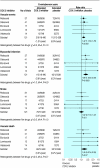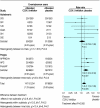Do selective cyclo-oxygenase-2 inhibitors and traditional non-steroidal anti-inflammatory drugs increase the risk of atherothrombosis? Meta-analysis of randomised trials
- PMID: 16740558
- PMCID: PMC1473048
- DOI: 10.1136/bmj.332.7553.1302
Do selective cyclo-oxygenase-2 inhibitors and traditional non-steroidal anti-inflammatory drugs increase the risk of atherothrombosis? Meta-analysis of randomised trials
Abstract
Objective: To assess the effects of selective cyclo-oxygenase-2 (COX 2) inhibitors and traditional non-steroidal anti-inflammatory drugs (NSAIDs) on the risk of vascular events.
Design: Meta-analysis of published and unpublished tabular data from randomised trials, with indirect estimation of the effects of traditional NSAIDs.
Data sources: Medline and Embase (January 1966 to April 2005); Food and Drug Administration records; and data on file from Novartis, Pfizer, and Merck.
Review methods: Eligible studies were randomised trials that included a comparison of a selective COX 2 inhibitor versus placebo or a selective COX 2 inhibitor versus a traditional NSAID, of at least four weeks' duration, with information on serious vascular events (defined as myocardial infarction, stroke, or vascular death). Individual investigators and manufacturers provided information on the number of patients randomised, numbers of vascular events, and the person time of follow-up for each randomised group.
Results: In placebo comparisons, allocation to a selective COX 2 inhibitor was associated with a 42% relative increase in the incidence of serious vascular events (1.2%/year v 0.9%/year; rate ratio 1.42, 95% confidence interval 1.13 to 1.78; P = 0.003), with no significant heterogeneity among the different selective COX 2 inhibitors. This was chiefly attributable to an increased risk of myocardial infarction (0.6%/year v 0.3%/year; 1.86, 1.33 to 2.59; P = 0.0003), with little apparent difference in other vascular outcomes. Among trials of at least one year's duration (mean 2.7 years), the rate ratio for vascular events was 1.45 (1.12 to 1.89; P = 0.005). Overall, the incidence of serious vascular events was similar between a selective COX 2 inhibitor and any traditional NSAID (1.0%/year v 0.9%/year; 1.16, 0.97 to 1.38; P = 0.1). However, statistical heterogeneity (P = 0.001) was found between trials of a selective COX 2 inhibitor versus naproxen (1.57, 1.21 to 2.03) and of a selective COX 2 inhibitor versus non-naproxen NSAIDs (0.88, 0.69 to 1.12). The summary rate ratio for vascular events, compared with placebo, was 0.92 (0.67 to 1.26) for naproxen, 1.51 (0.96 to 2.37) for ibuprofen, and 1.63 (1.12 to 2.37) for diclofenac.
Conclusions: Selective COX 2 inhibitors are associated with a moderate increase in the risk of vascular events, as are high dose regimens of ibuprofen and diclofenac, but high dose naproxen is not associated with such an excess.
Figures



Comment in
-
Life without COX 2 inhibitors.BMJ. 2006 Jun 3;332(7553):1287-8. doi: 10.1136/bmj.332.7553.1287. BMJ. 2006. PMID: 16740535 Free PMC article. No abstract available.
-
Life without COX 2 inhibitors: risks and benefits are determined by dose and potency.BMJ. 2006 Jun 17;332(7555):1451-2. doi: 10.1136/bmj.332.7555.1451-b. BMJ. 2006. PMID: 16777893 Free PMC article. No abstract available.
-
Review: selective COX-2 inhibitors increase vascular events more than placebo and naproxen, but not more than other NSAIDs.ACP J Club. 2006 Nov-Dec;145(3):66. ACP J Club. 2006. PMID: 17080978 No abstract available.
-
Review: Selective COX 2 inhibitors increase vascular events more than placebo and naproxen but not more than other NSAIDs.Evid Based Med. 2006 Dec;11(6):171. doi: 10.1136/ebm.11.6.171. Evid Based Med. 2006. PMID: 17213165 No abstract available.
References
-
- FitzGerald GA, Patrono C. The coxibs, selective inhibitors of cyclooxygenase-2. N Engl J Med 2001;345: 433-42. - PubMed
-
- Bombardier C, Laine L, Reicin A, Shapiro D, Burgos-Vargas R, Davis B, et al. Comparison of upper gastrointestinal toxicity of rofecoxib and naproxen in patients with rheumatoid arthritis. N Engl J Med 2000;343: 1520-8. - PubMed
-
- Schnitzer TJ, Burmester GR, Mysler E, Hochberg MC, Doherty M, Ehrsam E, et al. Comparison of lumiracoxib with naproxen and ibuprofen in the therapeutic arthritis research and gastrointestinal event trial (TARGET), reduction in ulcer complications: randomised controlled trial. Lancet 2004;364: 665-74. - PubMed
-
- Bresalier RS, Sandler RS, Quan H, Bolognese JA, Oxenius B, Horgan K, et al. Cardiovascular events associated with rofecoxib in a colorectal adenoma chemoprevention trial. N Engl J Med 2005;352: 1092-102. - PubMed
-
- Solomon SD, McMurray JJ, Pfeffer MA, Wittes J, Fowler R, Finn P, et al. Cardiovascular risk associated with celecoxib in a clinical trial for colorectal adenoma prevention. N Engl J Med 2005;352: 1071-80. - PubMed
Publication types
MeSH terms
Substances
LinkOut - more resources
Full Text Sources
Other Literature Sources
Medical
Research Materials
Miscellaneous
